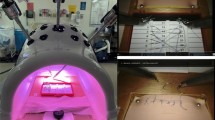Abstract
Background: We evaluated the effectiveness of five training methods-four structured and one unstructured-for teaching intracorporeal knot tying. Methods: Forty-three graduate students without prior laparoscopic experience were randomly assigned to one of five training groups, and their performance in 10 intracorporeal knot tying trials was evaluated, using time to complete a knot as the outcome measure. Results: The average knot tying times for the four structured groups were significantly faster than the unstructured group (p < 0.0001). AMONG THE FOUR STRUCTURED GROUPS, THE MINIMALLY INVASIVE SURGICAL TRAINER-VIRTUAL REALITY (MIST-VR) AND THE BOX TRAINER DRILLS SHOWED THE MOST RAPID IMPROVEMENTS. THE MIST-VR IMPROVED AVERAGE SUTURING TIME FROM TRIAL ONE TO TRIAL TWO (P = 0.05), THE BOX TRAINER DRILLS GROUP IMPROVED FROM TRIAL ONE TO TRIAL FOUR (P = 0.01), AND THE OTHER TWO GROUPS SHOWED SLOWER IMPROVEMENTS. STATISTICALLY SIGNIFICANT CORRELATIONS WERE OBSERVED BETWEEN SCORES ON MIST-VR TASKS AND AVERAGE KNOT TYING TIMES (R > 0.7, p < 0.05). Conclusion: Structured training can be useful for the development of laparoscopic skills. MIST-VR is a valuable part of this training, particularly in the objective evaluation of performance.
Similar content being viewed by others
Author information
Authors and Affiliations
Rights and permissions
About this article
Cite this article
Pearson, A., Gallagher, A., Rosser, J. et al. Evaluation of structured and quantitative training methods for teaching intracorporeal knot tying. Surg Endosc 16, 130–137 (2002). https://doi.org/10.1007/s00464-001-8113-y
Received:
Accepted:
Published:
Issue Date:
DOI: https://doi.org/10.1007/s00464-001-8113-y




